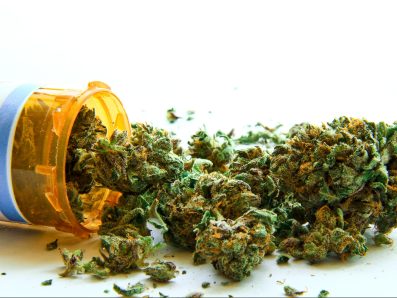
By Josh Kaplan
In part one of this series, we took a look at some of the most impactful studies in medical cannabis, specifically those relating to CBD. This next installment highlights several cannabis wins beyond CBD, as it shows promise in healthy aging, neurodegenerative disease, and more.
Cannabis is a powerful weapon against the opioid epidemic.
Source: International Journal of Drug Policy, April 2017 andPLoS One, November 2017

One of the biggest health news stories of 2017 has been the escalating need to address the opioid crisis. President Trump declared it a “national emergency,” but in addition to not allotting sufficient resources to prevent problematic opioid use, the Trump administration’s combat strategy doesn’t include cannabis. Research published in 2017 suggests that it should.84% of patients who received access to medical cannabis reduced their opioid prescriptions, compared to 45% in the comparison group.
Association studies over the last couple of years have identified that there are fewer opioid-related overdoses in states with access to medicinal cannabis. But those studies didn’t directly address whether medical cannabis led to improved pain management as an opioid substitute.
Several studies published in 2017 address these issues. One surveyed 271 Canadian patientswho were seeking prescription drug treatment for a variety of ailments including pain, anxiety, and depression; among these, 63% reported that cannabis substituted for their prescription medications. Specifically among pain patients, 30% reported that they swapped out their prescription opioids for cannabis. Patients reported that one of their greatest reasons for switching from opioids to cannabis wasn’t necessarily because of better symptom management (after all, opioids are effective pain killers…initially), but because there were fewer side effects associated with cannabis use.
University of New Mexico scientists put the substitutability of cannabis for opioids to the test in a cohort of chronic pain patients. The study compared prescription opioid use, mostly to treat back pain, between patients enrolled or not enrolled in New Mexico’s Medical Cannabis Program. They found that 84% of patients who received access to medical cannabis reduced their opioid prescriptions, compared to 45% in the comparison group. Notably, 41% of the cannabis users stopped using opioids altogether.
As described in previous surveys, cannabis use was not found to cause any serious side effects. Instead, it was associated with improved measures of quality of life with noted benefits to their social and activity levels, as well as boosted concentration.
These studies are the latest to support cannabis’ benefits in reducing opioid use. They find that cannabis can either substitute for prescription pain medication or supplement its effect, thus requiring fewer opioid pills to be consumed. And all of this with few side-effects!
Low doses of THC promote healthy brain aging.
Source: Nature Medicine, June 2017

As the mature brain ages in adulthood, its endocannabinoid systemweakens. The number of CB1 receptors–the receptors through which cannabis takes its classic effect–decrease with age, and the ones that remain are less effective. It’s thought that the weakened endocannabinoid system in the elderly contributes to their cognitive decline. This past spring, a research team from Germany reported that consistently activating CB1 receptors with low doses of THC prevents age-related cognitive decline in mice.In old mice, THC increased the number of connections brain cells made with one another in the hippocampus.
For 28 days, scientists gave a single low-dose of THC to young and old mice, after which they were tested for learning, memory, and cognitive flexibility (i.e., how well they could adapt to changing instructions). Old mice generally perform worse than young mice in these tasks, but THC impaired performance in young mice. However, old mice treated with THC performed similarly to their younger cohorts that did not receive THC, revealing that THC can impair brain function in the young, but rescue age-related decline in old animals.
These beneficial effects of THC in old mice were associated with positive changes at the level of individual brain cells. With aging, the number of connections between brain cells decreases. However, in old mice, THC increased the number of connections brain cells made with one another in a brain region called the hippocampus, which has important roles in learning and memory, and stress and anxiety. In fact, old mice treated with THC had a similar number of connections as untreated young mice.
The scientists revealed that one way in which low-dose THC promotes healthy brain aging is by impacting the pattern in which certain genes are expressed. Genes, which are the DNA instructions for building all the proteins in your body, are differentially expressed depending on age; there are “young” gene expression patterns and “old” gene expression patterns. One of the marquee findings in this study was that low-dose THC shifted the old mice’s gene expression to look like that of the young animals.
These results highlight the differential impact that THC can have on the brain and behavior as a function of age. But while many seek to better understand the harm that THC can have in the developing brain, this study provides the first in a hopefully growing body of evidence showing the benefits it can have in the aged brain.
Cannabis tames symptoms of Parkinson’s disease.
Source: Clinical Neuropharmacology, November 2017

Cannabis cannot cure Parkinson’s disease, but there’s now evidence that cannabis can relieve many of the devastating symptoms associated with the disease. Parkinson’s disease is characterized by cognitive problems, difficulty initiating movement, impaired gait and balance, and tremor. Many Parkinson’s disease patients also report an increased sensitivity to pain.
In a pilot study of 40 Parkinson’s disease patients, scientists from Tel Aviv University in Israel found that smoking medicinal cannabis for an average of 19 months improved many of the symptoms associated with the disease. 82% of participants reported that cannabis improved their overall symptoms. Cannabis reduced the number of falls, provided pain relief, reduced tremor, attenuated muscle stiffness, and improved sleep. Nearly 75% also reported that cannabis enhanced their mood, suggesting that cannabis may be an effective palliative care strategy for Parkinson’s disease patients.
One of the ways in which cannabis may be having its beneficial effects on Parkinson’s disease symptoms is by activating CB1 receptors in the substantia nigra, a small brain region where brain cells are selectively destroyed in the disease. Activating CB1 receptors in this brain region may relieve the cognitive impairment, walking difficulty, and tremor associated with the disease.
These benefits were associated with only minimal side effects. Cough was the most prevalent, and it’s likely that consuming cannabis in a method other than smoking would mitigate this side effect. The majority of participants reported that cannabis had no effect on memory, but 17% reported confusion and anxiety. The study did not control for type of cannabis consumed or measure cannabinoid content, but this is an important research direction to pursue in 2018.
Cannabis can help escalate your sex life.
Source: The Journal of Sexual Medicine, November 2017
There are many fear-inducing headlines when it comes to cannabis. But one of the latest to be debunked is that cannabis is bad for your sex life. Some claim that cannabis reduces sex drive or it impairs performance.
Stanford University physicians analyzed sexual activity data from over 50,000 men and women and concluded that cannabis use actually increases frequency of sexual activity. This increase was found in both men and women and consistent across demographic groups.
The study, however, did not address the effect of cannabis use on sexual performance. Regarding whether regular cannabis use impacts ability to attain an erection and achieve orgasm, the jury remains hung.
Looking Forward
In 2015, $21 million dollars in United States government funding went towards therapeutic cannabinoid research. That amount increased by a third in 2016, and is projected to rise even more in 2017. Almost half of this amount went towards studying CBD, which is thought to convey many of cannabis’ medicinal benefits. The increase in funding by the National Institute of Health is an acknowledgement of cannabis’ medicinal potential, and its recognition by the scientific community has led to a spike in the number of applications for Schedule I drug licenses from the Drug Enforcement Agency to study these benefits. It’s clear that momentum behind the medical cannabis movement is building, which will make for an exciting 2018… and beyond.
Originally published by Leafly


